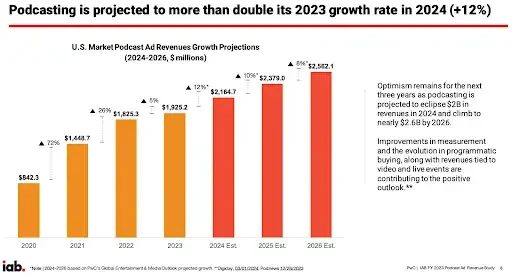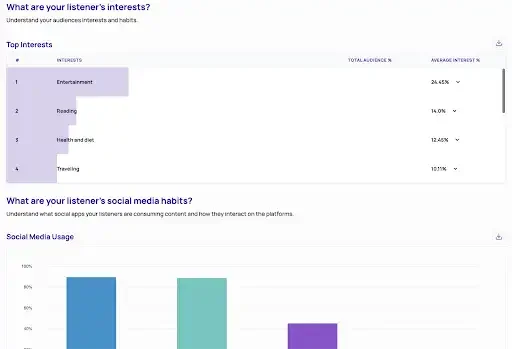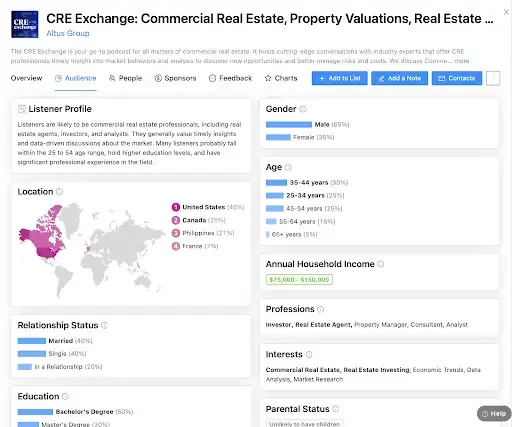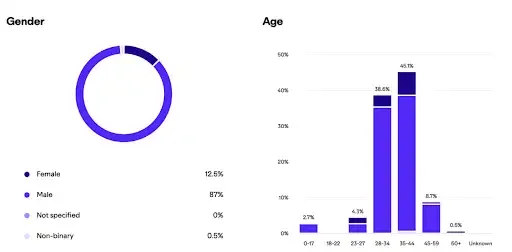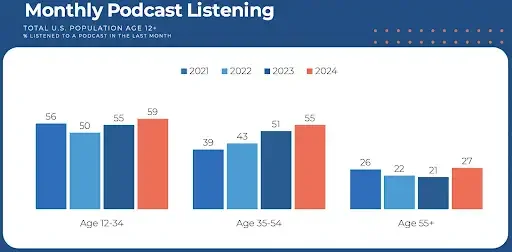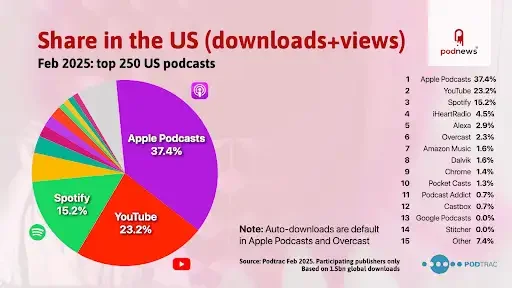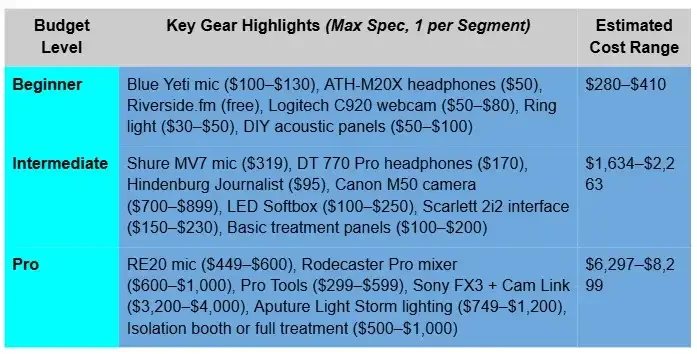B2B Podcasts by the Numbers: What the Latest Data Tells Us (and How to Act on It)
Podcasting has now become a full marketing channel. And like any channel, performance depends on how well you track, test, and act on performance metrics.
There are now over 4.5 million active podcasts worldwide competing for attention, and while B2B audiences are growing, listener behavior is shifting fast. High-performing teams are no longer guessing what works. They are tracking completion rates, analyzing listener drop-off, optimizing show titles for search, and turning guest segments into measurable revenue.
What the most effective marketers understand is this:
Episode length directly affects listen-through rates
Format structure influences how easily episodes can be repurposed into other formats like blog posts or LinkedIn carousels
Guest selection determines reach, relevance, and potential business outcomes
Data visibility is what makes any of it actionable.
With these signals, you can build a show that grows audience, strengthens brand authority, and supports your demand generation goals.
This guide breaks down what the latest B2B podcast data reveals about audience behavior, content performance, and where to focus next. More importantly, it shows exactly how to act on these insights.
Let’s dive in.
Podcast Market Size & Ad Spend
The podcast industry is booming in audience and ad spend. For B2B brands, knowing the market’s size and trends is critical to building a show that competes and converts.
How Big Is the Global Podcast Economy in 2025?
In 2025, the worldwide podcast audience is projected to reach 584.1 million listeners, driven by a need for on-demand, niche-specific content. The U.S. remains the largest market, but international listenership is expanding fast, particularly in Europe, Latin America, and Southeast Asia.
For B2B brands, this growth translates into a larger potential audience for industry-focused shows and a stronger case for using podcasts as a brand authority and demand generation channel.
As the listener base grows, so does the value of a well-optimized show in reaching decision-makers. B2B podcasting helps you get more qualified leads that you can’t capture through traditional ads alone.
For example, one of our clients has managed to distinguish themselves in the Talent Acquisition space. Within its first year, the Talent Acquisition Leaders podcast ranked #1 on Google Search for its category. More importantly, it helped the host, Ryan Dull close 9 new clients directly from relationships built through the show.
This demonstrates how a tightly focused B2B podcast can extend beyond reach and download numbers into measurable business growth, turning listenership into revenue.
Is Podcast Ad Spend Really Headed Past $5B Next Year?
Yes, and the growth rate shows no sign of slowing. Global podcast ad spend is expected to hit $5.2 billion in 2025 and surpass $5.5 billion by 2026. Other sources show that the B2B podcast advertising market is seeing an influx of $4 billion. And this pays off.
In the U.S. alone, the IAB projected ad revenues to climb past $2.5 billion by 2026 (IAB, 2023).
This surge is fueled by two trends:
Host-read ads driving performance: 46% of listeners say they are more likely to consider a product after hearing it promoted on a podcast, according to Edison Research.
Better targeting options: programmatic ad tech now allows for highly specific audience segmentation, making niche B2B content more appealing to advertisers than ever.
Competition for listener attention will increase as more brands invest in podcast ads. This makes owning your platform and building an audience you can reach without paying for every impression even more important.
Active vs. Inactive Podcast Shows: Why Only 18% Post Regularly
A 2024 Buzzsprout study shows that only 19% of all shows publish a new episode once or twice a month. That means the majority are either inactive or publish inconsistently.
For a B2B podcast, this is both a challenge and an opportunity.
The challenge is that inactive shows clutter directories, making discovery harder for listeners.
The opportunity is that consistent publishing instantly puts you ahead of 81% of the competition. Maintaining a predictable release schedule not only helps with audience retention but also signals credibility to potential sponsors, partners, and guests.
Pro tip: At Content Allies, we recommend publishing twice a month as it offers more opportunities with strategy, timeline and execution.
P.S: Podcast Strategy Basics: Choosing Your B2B Podcast Publishing Frequency
B2B Podcast Audience Profile & Listening Behavior
Understanding who listens and how they consume episodes is essential to your sales pipeline and your broader content marketing strategy. B2B podcast audiences are busy professionals, often tuning in during commutes, work breaks, or multitasking moments that shape engagement patterns.
Who Listens to B2B Podcasts?
Podcasts are now a mainstream habit for business audiences. In the U.S., 56% of monthly podcast listeners have a household income of $75,000 or more according to the previous Edison Research study we mentioned.
This makes them a high-value demographic for B2B marketers. Many hold senior roles, too. CMOs, CFOs, founders, and department heads are making podcasts an efficient channel for reaching decision-makers.
Some podcast analytics platforms like CoHost offer insights into your listener’s persona showing details like their interests and habits, type of lifestyle and social media behavior.
Rephonic is one of the few platforms that gives B2B podcasters detailed, data-driven insights into their audience. Instead of guessing who is listening, you get a breakdown of demographics, locations, income ranges, and professional interests that matter most for business shows.
By using this type of data, you can back up claims like “our audience is 65% male, mostly in the U.S. and Canada, with household incomes between $75,000 and $150,000.” That level of precision makes it easier to create pipeline opportunities, attract sponsors, align content to listener interests, and prove ROI.
Engage Professionals and Influencers with Targeted Campaigns
At Content Allies, we help clients go beyond organic reach by running LinkedIn Sponsored Content campaigns that put podcast episodes directly in front of their ideal audience. Using LinkedIn’s advanced targeting, we can target by job title, industry, seniority, company size, and even specific accounts. This ensures your episodes reach the professionals and influencers most likely to engage.
Case in point: In a campaign for Wiley Partner Solutions, targeted LinkedIn promotions drove significant audience growth and content engagement by helping the brand reach their specific target ICP.
Podcast Content Consumption by Gender
Gender distribution is balanced overall, but in many B2B niches, male listenership tends to skew higher. Your subscriber base can vary by sector, so tracking your own audience data in platforms like Spotify for Podcasters is critical for refining targeting and guest outreach.
Decision-Maker Density: The Majority Hold Buying Power
53% of weekly podcast listeners agree that they hold influence over purchasing decisions at work. For B2B brands, that means a well-crafted episode can directly shape buying conversations.
Action step: Align episode topics with your ICP’s current priorities and challenges, and invite industry influencers who match or influence your target buyer profile. This increases the odds that content drives measurable business outcomes.
Of course, you'll want to look at relevant key performance indicators, like website traffic on your landing page, episode downloads, organic search, guest-to-client conversion rate, and client calls. Adjust your podcast plan and content marketing posts according to your episode performance.
P.S:. To learn how we do this for our clients at Content Allies, check out Beyond the Interview: How to Leverage Guest Content for Long-Term Relationships
Age-Band Growth: 59% of 12-34s & 55% of 35-54s Tune In Monthly
Podcasting spans generations, but its fastest growth is in younger professionals. In 2024, 59% of people aged 12–34 and 55% of those aged 35–54 in the U.S. listened to podcasts monthly.
For B2B marketers, this signals a growing pool of early-career and mid-career professionals who will be tomorrow’s senior decision-makers. Nurturing this audience now can build brand loyalty before they hit top leadership roles.
68% Finish Podcast Episodes and How to Leverage It
Completion rates are a rare bright spot in digital media. According to research, almost 7 in 10 listeners (68%) say they typically listen to an entire podcast episode. That’s far higher than average dwell times for video or blog content.
How to leverage it:
Audit episode analytics in Apple Podcasts, Spotify for Podcasters, and YouTube Podcasts to pinpoint drop-off points, replays, and spikes in engagement. Use these insights to improve pacing and tighten segments.
Place key messaging and calls to action throughout the episode, not just at the end.
Use mid-roll CTAs when attention is still high.
Repurpose high-retention segments into standalone social and video content to extend reach.
For example, a recent B2B podcast episode we produced ran 35:51 with 89% retention through the first three quartiles, but retention dropped to 56% in the final minutes. The analytics showed spikes at 7:15, 17:55, and 28:40, likely caused by standout moments or replays.
From this, we recommended:
Adding mid-episode CTAs at high-retention points instead of at the end.
Trimming or reworking the final three to four minutes to prevent drop-off.
Repurposing replayed moments as highlight clips for promotion. This will increase social media engagement across distribution channels.
Maintaining the existing structure for the first 75% of the episode since it was performing strongly.
As you can see, combining industry benchmarks with your own platform analytics, is how you can build an episode structure that keeps your audience engaged from start to finish and gives you more assets to promote.
Platform & Device B2B Podcast Trends
Podcast audiences are shifting how and where they listen. Understanding platform preferences and device habits helps B2B marketers tailor formats, distribution, and promotion to meet audiences where they already engage.
Spotify vs. Apple Podcasts vs. YouTube: Where Are B2B Ears Going?
Apple Podcasts continues to lead U.S. podcast consumption with 37.4% of downloads, followed by YouTube at 23.2% and Spotify at 15.2%. YouTube’s podcast market size signals growing dominance for video-driven shows.
What this means for B2B marketers: Distributing your show across all three platforms is non-negotiable, but the content format should align with where your audience spends most of their time. Audio-first episodes thrive on Apple and Spotify, while YouTube offers discoverability advantages for video podcasts and repurposed clips.
How Content Allies helps: We optimize distribution so episodes are published natively on all major podcast hosting platforms. We then use analytics from Spotify for Podcasters, Apple Podcasts Connect, and YouTube Podcasts to pinpoint where your audience is growing fastest. This allows us to double down on the platform delivering the highest ROI.
Mobile-First Reality: 73% Listen on Smartphones
Podcast listening is overwhelmingly mobile. 73% of podcast consumers listen on a smartphone, according to the 2024 Buzzsprout study we previously cited. For B2B shows, this means your episode titles, descriptions, and cover art must be optimized for small screens and fast scrolling.
Content Allies tip: We design cover art and audiograms specifically for mobile feeds, ensuring text is legible and visuals stand out even at thumbnail size. This small adjustment can significantly improve click-to-listen rates.
Does YouTube’s Video Shift Change Your Podcast Format Plan?
Yes, especially if your ICP is active on LinkedIn or YouTube. A study by Morning Consult shows that nearly 46% of podcast listeners now prefer to watch shows. YouTube’s integration of a dedicated Podcasts tab and push for video-first formats makes it a viable primary platform for discovery.
How to act: For B2B podcasts, we recommend adopting a video first content strategy. This opens the door to YouTube publishing, LinkedIn video snippets, and visual content repurposing without doubling your production workload.
Your competitors are already capitalizing on this trend.
One 2025 CoHost study notes that 85% of companies capture video when producing podcasts, and 65% of showrunners post short clips weekly. This aligns with platform algorithms that prioritize short-form, native video content.
Podcast Content Formats & Episode Strategy
Podcast format and structure directly influence engagement, retention, and shareability. Choosing the right approach and scripting it intentionally ensures every episode delivers value, builds authority, and maximizes your production investment.
Are Podcast Interviews Still King? Market Share & Future Forecasts
Interviews still dominate the podcast format, representing about 63% of active shows (CoHost Podcasting, 2025). For B2B podcasts, interviews remain powerful because they combine subject-matter expertise with the ability to tap into a guest’s existing audience.
The most effective interview episodes are planned with a clear goal, a structured sequence of thematic segments, and intentional placement of CTAs at moments when attention is highest. Looking ahead, listener fatigue with generic Q&A formats will drive growth in hybrid interview styles mixing narrative elements, recurring segments, and tighter editing to create a richer listening experience.
Solo vs. Panel vs. Narrative: When Each Podcast Format Wins
Solo episodes are the fastest way to publish timely thought leadership. A concise outline keeps delivery on track while allowing flexibility for personality and authentic storytelling.
Panel episodes work best for multi-perspective topics such as industry trends or debates. Success depends on clear segment flow, planned speaker handoffs, and pacing that keeps all voices balanced.
Narrative formats deliver the most polished, story-driven experience. They’re ideal for case studies, brand storytelling, or projects involving multiple stakeholders. These require deeper preparation; mapping acts, integrating guest clips, and scripting transitions to maintain clarity and engagement.
The strongest content strategies mix formats, selecting the right one based on audience needs, message complexity, and available resources.
What to read next: Podcast Scripting Made Easy: Agency-Level Examples & Tips That Work
What is the Ideal Episode Length for B2B Podcasts?
Podcast episode length matters, especially when your audience is juggling meetings, commutes, or quick work breaks. At Content Allies, we consistently see episodes under 30 minutes deliver 50% or higher consumption rates among B2B listeners because they fit neatly into daily routines without losing depth.
Most podcasts, including business shows, land in the 20–40 minute range, according to Buzzsprout and industry distribution data. In B2B formats, particularly marketing or strategy topics, that balance allows enough time to deliver insight without overextending attention.
Busy professionals appreciate concise content.
Examples include 10–15 minute episodes packed with tactical takeaways, especially effective for customer success or SaaS series. From our experience, areas like HR or staffing tend toward 20–35 minutes, while narrative or technical deep-dives can run longer if the pacing and storytelling engage consistently.
The bottom line: shorter episodes build trust and complete listenership. If you're consistently hitting 50%+ completion, you’re in a strong position. If not, consider trimming content, tightening segments, and testing pacing.
For a deeper dive, check out How Long Should a B2B Podcast Be? Data-Backed Insights for Engagement
“Video-Plus-Shorts” Workflow: Capitalize on Weekly Clip Sharing
Repurposing podcast content visually is one of the most efficient ways to expand reach and keep your audience engaged between episodes. Once you've recorded an episode (ideally with video), extract 3–5 high-impact clips per week for promotion across platforms like LinkedIn, YouTube Shorts, and Twitter.
These clips should highlight standout insights, bold takeaways, or memorable guest moments. Queue them strategically to stay present in your audience’s feed, support discovery algorithms, and reinforce episode themes between full-episode releases.
Podcast Production Costs & Resource Allocation
Understanding the real costs of producing a B2B podcast and knowing where to invest first will help you allocate resources for the best return while avoiding low-impact expenses.
What Does a B2B Podcast Cost Per Episode in 2025?
At the simplest level, a business-grade podcast with minimal editing and in-house coordination may cost $500 to $1,000 per episode. Mid-tier productions that include more refined editing, guest preparation, and creative oversight often fall between $3,000 and $5,000 per month. These may be billed per episode or packaged as a monthly service.
On the high end, fully produced narrative-style or branded podcasts with multi-location recording, custom scripting, original music, and audience development campaigns can reach $100,000 to $250,000+ per season. These shows are built like editorial products, with every detail from story arc to sound design shaped for maximum impact.
However, you can learn how to build a podcast studio on any budget.
In-House vs. Agency Podcast Cost Curves
Producing a podcast in-house can reduce direct costs and provide flexibility, but it also places the full burden of planning, production, editing, and promotion on your team. This often means diverting skilled staff from other strategic priorities.
Hiring a podcast consultant can help in-house teams avoid costly mistakes and improve efficiency without committing to the full expense of an agency.
If you need help, here's a list of the top podcasting consultants currently available, with a brief explanation of the services they provide.
On the agency side, costs vary widely depending on services and format. Lightweight production support that focuses on editing and basic production typically ranges from $500 to $1,500 per episode. B2B podcasts in this tier usually include streamlined editing and minimal creative strategy.
Leading full-service agencies that handle scripting, guest management, design, and promotional support like Content Allies often charge $3,500 to $5,000 per episode or month. This pricing tier aligns with standard offerings for branded business shows.
For high-end branded or narrative-driven productions, budgets increase significantly. Lower Street’s 2025 benchmarks show that premium, full-season productions range from $40,000 to $100,000+ per season, while strategic-tier podcasts designed for storytelling and long-term authority can reach $100,000 to $250,000+ per season.
If you're leaning more toward partnering with a podcast agency, we put together a list of the Top 20 B2B Podcast Production Agencies & Companies in 2025.
Equipment vs. Software vs. Talent: Spend Order for Maximum Impact
Your podcast’s audio and visual quality starts with the right gear. Even the most compelling host or guest can lose impact if the sound is muffled or the video is poorly lit. The goal is to create a clean, consistent setup that supports your show’s format and scales with your growth.
Audio and video quality anchor a podcast’s professionalism. Start with equipment that ensures clarity and reliability first, then layer in extras as your production goals expand.
At the most basic level, a solid microphone and a quiet space can do the job. As you invest more, you gain flexibility, visual capability, and consistency. To make gear decisions easier, we have formatted the “Podcast Studio for Every Budget” tier list, built from expert recommendations, into this table.
This tiered setup keeps your spend strategic. Start small with gear that gets you sounding clear. If you add video, step up to more robust cameras, audio interfaces, and lighting. When your format scales, like narrative or multi-guest recording, you can justify premium gear and treatment.
For more advice on building your equipment setup within any budget, and how it ties into your format and production process, check out our full guide: Build a Podcast Studio on Any Budget.
Quick-Start Checklist: Data-Driven Steps to Level-Up Your Branded Show
Launching a branded podcast is one thing, but turning it into a growth channel is another. Use this checklist to make sure your show is building an audience, strengthening brand equity, and driving measurable results.
1. Audit audience analytics: Review Apple Podcasts, Spotify for Podcasters, and YouTube Podcasts data per episode. Identify retention drop-off points, replays, and spikes. Compare against benchmarks to understand where content is resonating or losing attention.
2. Profile & target your ideal listener: Define audience segments by job title, income level, and decision-making authority. Use LinkedIn Sponsored Content to run targeted campaigns toward relevant professionals, measuring traffic and downloads from LinkedIn to validate audience alignment.
3. Test & optimize formats: Experiment with interviews, solo episodes, panels, and narrative formats. Track completion rates and engagement for each style. Retain the formats that maximize retention among your ICP.
4. Calibrate episode length to listening habits: Align episode duration to audience behavior. For B2B shows, episodes under 30 minutes often achieve 50%+ consumption. Shorten or tighten content if completion rates are lagging.
5. Repurpose strategically: Implement a “Video-Plus-Shorts” workflow by extracting 3–5 clips weekly from recorded episodes. Share across LinkedIn, YouTube Shorts, and other platforms to reinforce messaging and boost discovery between full episodes.
6. Refine production & budget allocation: Invest first in skilled talent (host, producer, editor), then in core equipment and software. Upgrade to premium features like advanced editing or custom sound design only if data shows they improve audience retention or brand impact.
7. Choose the right production model: If in-house, consider hiring a podcast consultant to close expertise gaps. If agency-based, compare service tiers and format-specific costs to ensure you’re paying for the right mix of creative, technical, and promotional support.
8. Maintain a consistent release cadence: Set and stick to a publishing schedule that balances quality and frequency. Use pre-recording buffers to avoid gaps, and track audience trends over time to fine-tune cadence.
9. Review & iterate quarterly: Every 90 days, analyze performance across all metrics like audience profile shifts, retention, format success, ROI, and promotion effectiveness. Adjust your strategy based on what’s working and where there’s room to grow. At Content Allies, we recommend setting clear quarterly goals (e.g., lift retention by 10%, grow LinkedIn traffic share by 15%, or boost downloads among target job titles). Tie each adjustment to a specific KPI so you can refine your show in a way that compounds results over time.
Turn Podcast Statistics Into ROI with Content Allies
In 2025, the most effective B2B podcasts are built on insights. Industry statistics (as well as your own analytics) reveal who’s listening, what keeps them engaged, and how shows convert into measurable business outcomes. From pinpointing decision-maker audiences to optimizing content formats, advanced analytics are the edge that separates average shows from growth engines.
And we know how to use both industry trends and your own metrics.
That's how we helped enterprise podcasts like the Talent Acquisition Leader Podcast rank #1 on Google and win 9 new clients in its first year. We’ve also supported branded shows like CRE Exchange and Meta Business, Innovation and Technology to achieve thousands of downloads per episode and ~70% consumption rates.
We can help you do the same.
Whether you need listener insights, smarter growth strategies, or data-backed content planning, Content Allies equips you with the analytics and strategy to turn your podcast into a revenue channel.
If you’re ready to put your data to work and maximize your podcast ROI, let’s talk.
Frequently Asked Questions (FAQs)
How do advanced analytics help target decision-makers more precisely in 2025?
Advanced analytics tools segment listeners by firmographics, job titles, and engagement trends, helping brands identify and reach senior decision-makers instead of broad consumer audiences.
How are B2B marketers using analytics to improve podcast ROI this year?
Marketers are tying podcast metrics directly to lead generation, pipeline contribution, and closed-won deals. Attribution dashboards connect listening activity with CRM and marketing automation systems.
How does listener behavior data influence content strategies for B2B podcasts?
Behavioral insights like episode drop-off points, replay spikes, and preferred formats guide editorial planning. Brands double down on content that keeps decision-makers engaged and eliminate segments that underperform.
What new metrics are being used to measure podcast success in 2025?
Beyond downloads, teams now track completion rates, average consumption percentage, listener-to-lead conversion, and deal velocity influenced by podcast touchpoints.
How are analytics platforms shaping paid promotion strategies for B2B podcasts?
Ad spend is increasingly optimized by matching listener demographics with target ICPs. Platforms highlight which channels (LinkedIn, YouTube, Spotify) yield the highest engagement from decision-makers, driving smarter promotion investments.


